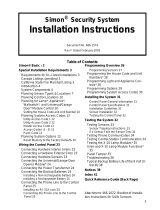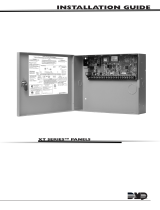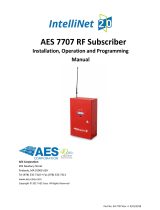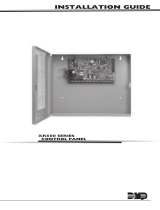Page is loading ...

Dialog QS1000 Allegro Remote Station
Installation Instructions
Product summary
The Dialog™ QS1000 Allegro Remote Station (60-982-95R) is
a wireless wall-mount remote station designed to provide
remote security system control and status checking. The
Remote Station allows the user to perform the following
functions:
• Arming and Disarming
• Activating Police, Auxiliary and Fire Panic Alarms
• Checking of System Status
The remote station has the following features:
• One Hardwire Input
• Built-in Siren
• Wall Tamper
• Custom Liquid Crystal Display (LCD)
• Armed and Ready LEDs
Programming
The following steps describe the general process for
programming (learning) the remote station into panel memory.
Refer to the specific panel Installation Instructions or
Reference Manual for complete programming details.
To program the remote station into the system:
1.
Enter the appropriate code to access the panel menus.
2. Enter the panel Learn/Add Sensors/Devices menu.
3. Change the sensor number if necessary.
4. Press and hold both Police Panic buttons on the remote
station.
To set the volume of status beeps from the remote station:
1.
Press and hold the 8 button. The remote station will beep
every 2 seconds.
2. Release the button when the desired volume is reached.
Mounting
Use the following procedure to mount remote station to the wall
or wall studs.
Caution: You must be free of static electricity before handling
circuit boards. Wear a grounding strap or touch a bare metal
surface to discharge static electricity.
To mount the remote station:
Figure 1. Tab location
Tab
Antenna
(Standard)
1. Remove the remote station from the back mounting plate
by lifting the tab located on the top and pulling back.
2. Remove the wiring knockout.
Note: The wiring knockout is approximately the same
width as a wall stud. If mounting the remote station to a
wall stud be sure you have enough room to feed the wires
through the knockout.
3. Feed all device wires through the knockout and place the
back mounting plate in position against the wall.
4. Level the back mounting plate and mark the top and
bottom mounting holes.
5. Install anchors where studs are not present.
P/N 466-2091 • REV B • January 2011 1

6. Partially insert a screw into the top mounting hole location
then hang the back mounting plate on the screw.
7. Recheck for level, insert the lower screw, and tighten both
mounting screws.
8. Install the antenna. There are three antenna options to
choose from:
• Standard Range- Leave the antenna as is.
• Extended Range - Attach the optional antenna housing
(included in the accessory pack) to the remote station.
a. Push the antenna housing down into the top right hole
of the remote station until it snaps into place (see
Figure 2).
b. Remove the antenna loop from the last clip on the
remote station cabinet and insert it into the antenna
housing.
• Longest Range - Hang the antenna in the wall.
a. When you mark the back mounting plate’s two
mounting holes, also mark where the antenna hole is
(see Figure 2
for antenna wire hole location).
b. Where the antenna hole was marked, drill a hole into
the wall.
c. Remove the antenna loop (see Figure 2
) from the
remote station cabinet clips and feed through the
antenna hole and down into the wall
Figure 2. Antenna configurations
Clips
Antenna
Loop
Antenna
Housing
Push Down
Into Remote
Antenna Wiring
Optional Antenna Housing
Antenna
Wire Hole
Wire
Clip
Mounting
Knockout
Tam pe r
Switch
Holes
Wiring Hole (Longest Range)
(Extended Range)
(Standard Range)
Station
9. Place the remote station cabinet into the back mounting
plate and snap into place.
Connecting Detection Devices to the remote station
The remote station has one hardwire input. The input is
supervised using a 2.2 k Ohm, end-of-line (EOL) resistor
(included with the remote station) at the last device on the
circuit. It accepts normally closed (N/C) detection devices.
Figure 3
shows the typical wiring for a N/C door/window
intrusion detection.
Figure 3. Wiring N/C intrusion detection devices
Remote Station Terminals
Normally
Closed
(N/C)
Contacts
In Series
2.2 k Ohm
EOL Resistor
49-467
The maximum loop resistance for each zone input is 300
ohms, plus the 2.2 k Ohm EOL resistor.
IMPORTANT: The 2.2 kOhm EOL resistor must be installed
across terminal 3 and 4 even when no detection device is
connected. If this is not done the remote station will indicate
the zone is open.
Connecting the AC Power Transformer
Caution: Do not plug in the power transformer at this time. The
remote station must be powered up using the sequence of
steps described in Powering up the remote station
.
The remote station must be powered by a UL approved
transformer. Connect the power transformer to the remote
station as shown in Figure 4
.
Figure 4. Connecting a power transformer
Z
C
O
M
Z
O
N
E
AC
Connecting the Backup Battery Pack
The remote station will receive its primary power from an AC
class II transformer. In the event of an AC power failure, the
remote station will be powered by a battery pack containing
four rechargeable NiCd batteries.
2 Dialog QS1000 Allegro Remote Station Installation Instructions

Note: In Canada, use the AC power transformer without a
securing tab, (part no. 22-117-CN).
Specifications
Dialog QS1000 Allegro Remote Station Installation Instructions 3
Figure 5. Connecting the battery pack
Battery
Location
Wire Terminals
Pack
Battery Pack
Wire Channel
Battery Pack
Lead
Battery Connector
Model no. 60-982-95R
Compatibility Allegro™ Software Version 1.3 and later
RF frequency 319.5 + or - 140 kHz
Power source 8 or 9 VAC, minimum 300 mA (Must be a
Interlogix recommended transformer).
Battery type 4.8 VDC rechargeable NiCd battery pack
Typical standby current
Operating temp range 32° to 122° F (0° to 49° C)
Storage temp range -30° to 140° F (-34° to 60° C)
Relative humidity 90% non-condensing
Dimensions (in.) 7.5 x 6.75 x 1.5 (L x W x D)
Weight (lb) 1.0
Installation Wall mount
Nominal range 500 Feet, (150 m) open-air receiving range
To connect the backup battery pack:
1. Remove the remote station housing from the back
mounting plate by lifting the tab located on the top of the
remote station and pulling back.
2. Slide the battery pack into the space provided on the back
of the remote station (Figure 5).
Note: Be sure to run the ba
ttery pack wires below the
battery and through the wire channel.
Regulatory information
Manufacturer UTC Fire & Security Americas Corporation, Inc.
1275 Red Fox Rd., Arden Hills, MN 55112-6943,
USA
FCC compliance This device complies with FCC Rules Part 15.
Operation is subject to the following two
conditions.
This device may not cause harmful interference.
This device must accept any interference that
may be received, including interference that may
cause undesired operation.
Changes or modifications not expressly approved
by Interlogix can void the user’s authority to
operate the equipment.
FCC ID: B4Z-785B-ALTP
3.
Plug the battery pack lead into the slot provided next to
the wire terminals (Figure 5
).
4. Replace the remote station housing on the back mounting
plate and snap into place.
Note: Verif
y the front door is in place before replacing the
remote station on the mounting plate. It is not possible to
attach the door after the remote station is secured to the
mounting plate.
Powering up the remote station
After connecting and wiring all devices to the remote station,
you are ready to apply AC power to the remote station.
Contact information
To power up the remote station:
Plug the transformer into an outlet that is not controlled by a
switch or ground fault circuit interrupt (GFCI). Be sure to screw
the top of the transformer onto the outlet so that it doesn’t fall
out of the outlet.
For contact information, see www.utcfireandsecurity.com or
www
.interlogix.com.
For technical support, toll-free: 888.437.3287 in the US
including Alaska, Hawaii, Puerto Rico, and Canada. Outside
the tool-free area, contact your dealer.
W
ARNING: Be careful when securing the transformer to an
outlet with a metal cover. You could receive a serious shock if
the metal cover drops on to the prongs of the plug while you
are securing the transformer and cover to the outlet box. If the
remote station does not display anything, immediately unplug
the transformer and disconnect backup battery.
Cop
yright © 2011 Interlogix, a UTC Fire & Security Company.
All rights reserved.
/



